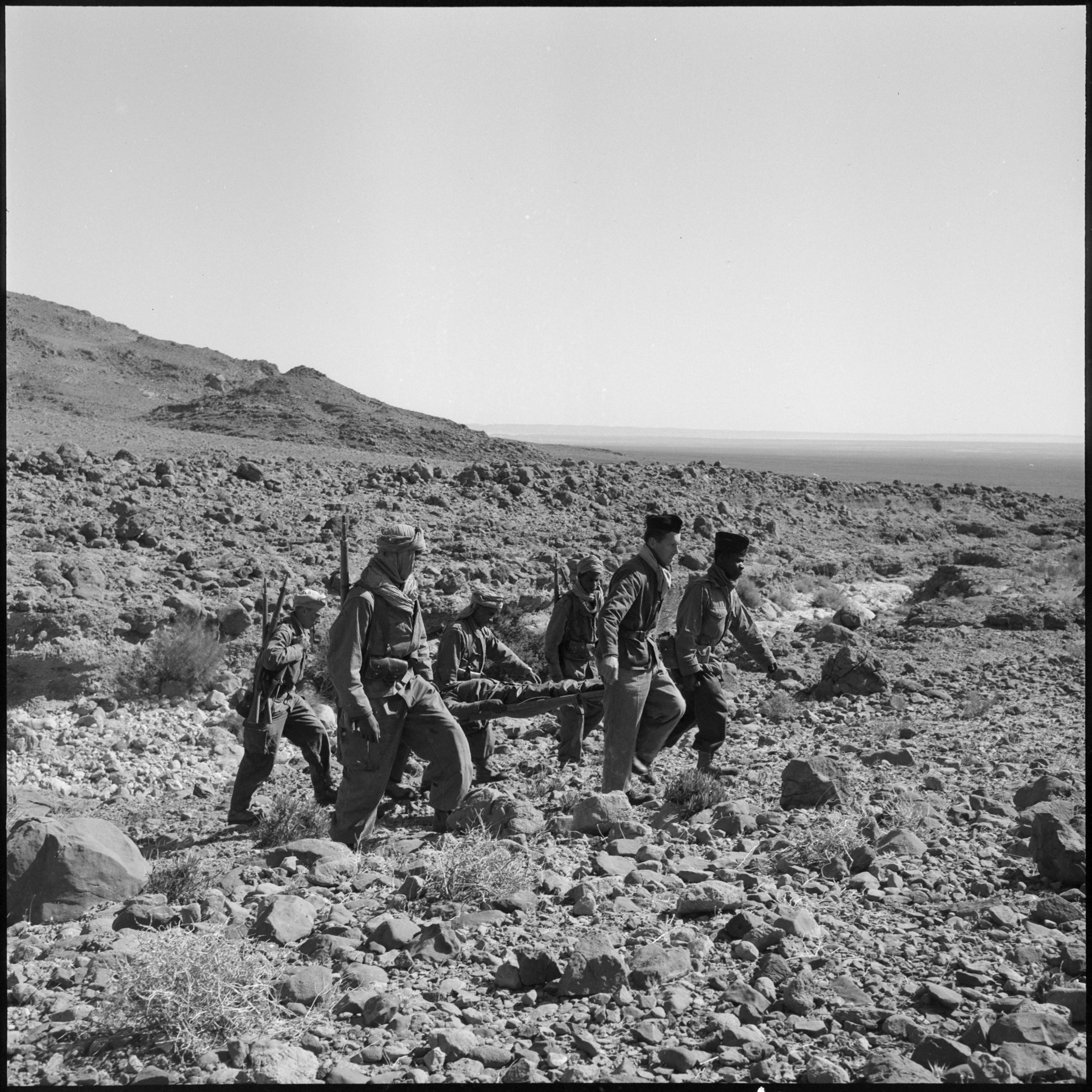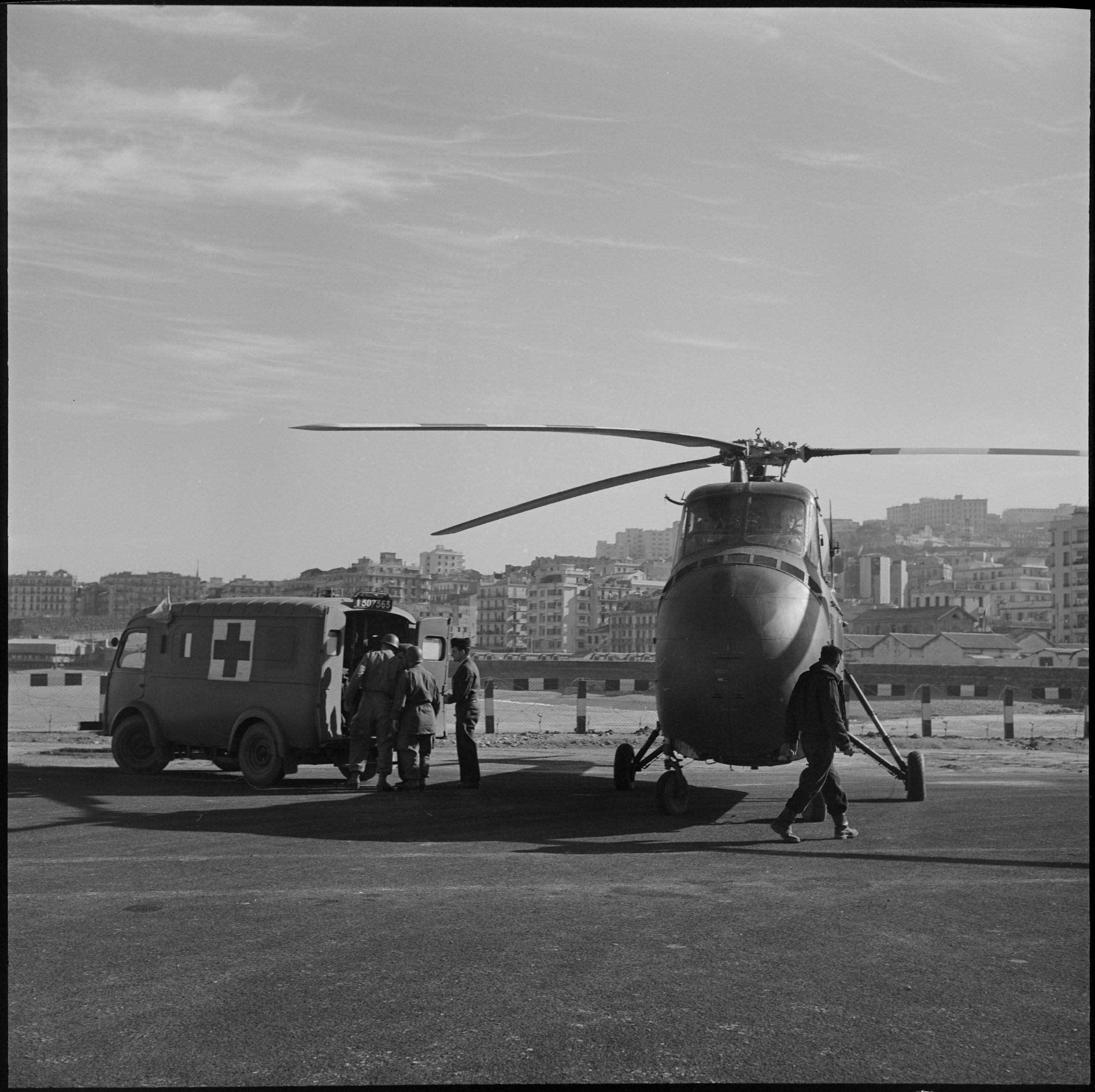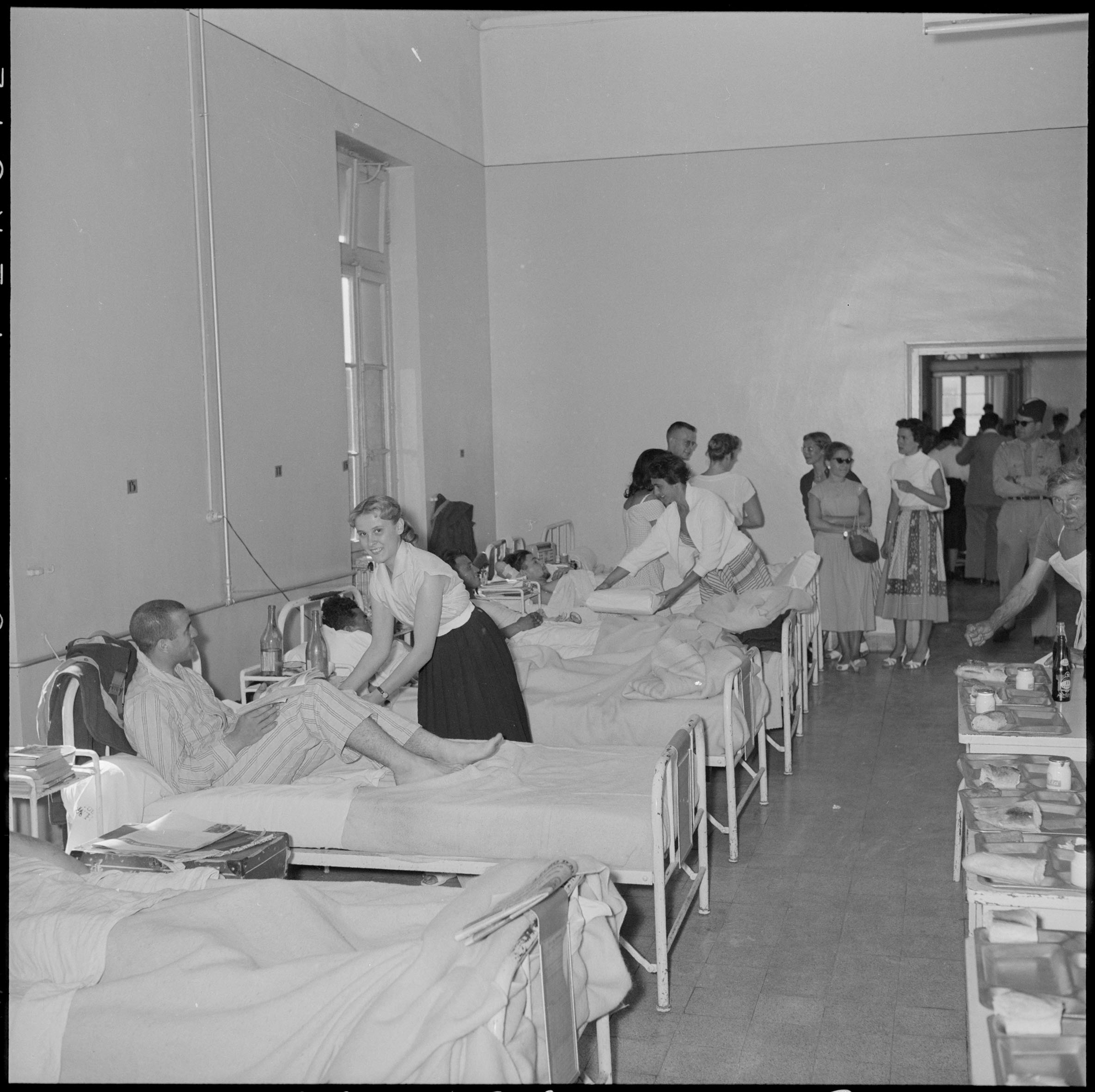Algeria’s wounded soldiers
Sous-titre
by Claude d’Abzac-Epezy


A wounded soldier on a stretcher. © Zygmond Michalowski/ECPAD/Défense
“Like a wisp of straw, I fell backwards and was immediately covered in blood [...]. I reacted quickly, turning onto my stomach, and managed to unbuckle my haversack, which relieved my shoulders. Instinctively, I raised my left hand to my lower jaw, which had a gaping hole in it, 7 or 8 cm across. I could likewise ‘feel’ that my right eye was split, and therefore lost. Although I was extremely weak and was steadily losing the feeling in my arms and legs, I realised I could get out of this, provided I remain conscious, I thought. So, throughout the journey, to keep myself from losing consciousness, I chanted: ‘I’m 20 years old, I don’t want to die. I’m alive! I’m 20 years old, I don’t want to die!’”
That is how Sergeant Jean Forestier remembered the traumatising feeling of imminent death, so often experienced by those wounded on the battlefield. [1] There are a great many accounts like this one [2] and often they resemble one another in their narration of moments of anguish, when the person is wounded or mutilated. That anguish could begin even before the first shots were fired, when chatting to one’s fellow soldiers.
“‘I hear Baron – you know, tall fellow with curly hair, armourer, left in February with the 56 1/C...’
‘Yeah?’
‘I hear he stepped on a mine. Lost both his legs.’” [3]
Being wounded in action
The danger hit home when the soldiers received orders to swap their bush hats for their helmets, which contained first-aid kits. If the confrontation was at the end of the day, they knew there would be no helicopter to come and collect the wounded until morning. Soldiers who were injured – mostly from bullet wounds sustained in violent clashes with the rebels, or from car accidents – had their wounds dressed by nurses, who also administered injections of antibiotics or morphine if their condition was critical. Two rifles with two combat jackets slung between them served as a makeshift stretcher. To help the wounded man remain conscious, his comrades or the medical staff would speak to him continually, trying to keep him awake:
“In view of my wound, the battalion doctor, a lieutenant, has decided to evacuate me to Laveran hospital in Constantine. He gave me a number of injections (tetanus, morphine) and I fell into a deep sleep, lying on a stretcher covered with a supply corps blanket, only to be shaken awake, have water splashed in my face and be made to drink. Then he made me stand on my feet, and the cool night air helped clear my head. ‘Where are we?’ he asked insistently. ‘Try to remember!’” [4]
Immediately behind the front line, a nurse would pin a first-aid card on the wounded man’s blanket and place a canvas roll under his head. It was often a long wait for the helicopter. When it arrived, the wounded man was placed on an enclosed stretcher, attached to the underside of the aircraft. If he succumbed to his wounds, the pilot of the helicopter would radio ahead to say he was carrying a “special case”, so they would know not to bother sending an ambulance; an ordinary van would do. [5] The wounded were then taken to a military or civilian hospital. Barbier-Hugo hospital in Algiers specialised in serious facial wounds. The big military hospitals – Maillot in Algiers, Baudens in Oran and Laveran in Constantine – were the apex of a network of dozens of civilian hospitals in smaller towns, which had signed agreements with the armed forces medical service to set aside wards and operating theatres and receive military medical staff.

A wounded serviceman arrives at Algiers heliport. © Georgetti/ECPAD/Défense
Staying in hospital
Hospital was a contrasting experience: the rank and file and NCOs were put in big communal wards, the officers were placed two or three to a room, while only a small number of high-ranking officers had a room to themselves. The nurses prompted mixed reactions: some, according to historian Jean-Charles Jauffret [6], became mistresses or wives, while others disappointed. Paul Fortu described the nurse who looked after him as “a dragon”:
“The nurse returned with a folded pair of pyjamas in her hand.
‘Would you mind bringing me some writing paper and an envelope to write to my wife, and some cigarettes too, please?’
‘The wounded aren’t allowed to smoke and I’m not a post office!’ she replied, and left.” [7]
In hospital, the wounded were confronted with the suffering of their comrades, and sometimes witnessed their deterioration and death. They had to bolster those who found out they were permanently disabled and would have to give up their dreams:
“I leaned over towards my companion in misfortune. His eyes were open and I could tell he was greatly distressed. We introduced ourselves. He was a second lieutenant, who had been shot in the kneecap two days earlier, in an ambush. He pointed to an X-ray on his bedside table.
'Look, old chap, my right leg has been permanently shortened by 4 cm. I have a limp for life. I went to Saint-Cyr for nothing. I don’t even know if they’ll keep me on in admin.’
‘You poor old thing, you might have ended up in a coffin. Console yourself with the thought that you’re alive!” [8]
Wounds and mutilation drove some to suicide: airborne nurse Jean-Pierre Vittori quotes the story of Joseph Zabiégala, who had both his legs amputated following a landmine injury on 26 March 1960, which left him in a coma for ten days.
“I was completely covered in a plaster cast and thought I was condemned to being paralysed. My bed was by the window. I felt like jumping out of it, to kill myself, but I couldn’t move. Around me, my comrades grumbled. They were badly wounded too. Another reason I wanted to end it all was so I wouldn’t have to see and hear them anymore.” [9]
La rééducation et le droit à pension
Depending on the severity of their wounds, servicemen were entitled to a long period of convalescence or medical repatriation. Some of the most serious cases were admitted to the Institution Nationale des Invalides, which put in place a rehabilitation programme. In January 1958, at the request of the head physician of that institution, Warrant Officer Pierre Clerc, a sports and physical education teacher at the Institut National des Sports (future INSEP), was seconded to Les Invalides to provide “sports-based rehabilitation exercises” for the severely wounded. Building on that success, on 10 October 1966, on the initiative of Lieutenant Georges Morin, himself severely wounded in the Algerian War, the Cercle Sportif de l’Institution Nationale des Invalides (CSINI) was set up to offer wounded servicemen and women the opportunity to practise different sports for leisure or competitively. Over the years, the CSINI has become one of the most important clubs in the Fédération Française Handisport, the French disability sports federation. It is the oldest sports rehabilitation organisation for wounded service personnel.
Enshrined in law on 6 August 1955, the entitlement to a pension gave all victims of the Algerian War and the fighting in Morocco and Tunisia the right to claim compensation for any harm they had suffered. The carte du combattant (veteran’s card) was awarded to North African veterans by Law 74-1044 of 9 December 1974. The basic prerequisites were: to have served at least 90 days (consecutive or otherwise) in a combat unit between 31 October 1954 and 2 July 1952 [10], to have received an individual citation, to have suffered a war wound recognised by the military authorities, and to have been evacuated from a combat unit as a result of a wound received or an illness contracted in the line of duty. Having a recognised wound was therefore important for victims to claim their entitlement. Pensions were awarded according to the level of invalidity, but they were often regarded as meagre in view of the harm suffered, and many applicants embarked on lengthy appeals processes, with support from organisations like the FNACA. Corporal Serge Puygrenier had his leg amputated after being hit by machine-gun fire in Kabylie in 1958 and was awarded a full pension, but the amount of his award was only 3 500 francs per month, worth about 60 euros today. Invalidity pensions were revised in 2012.

Wounded servicemen receive parcels at Maillot hospital, Algiers. © Jean Bouvier/ECPAD/Défense
Over 60 000 wounded in the French Army, mostly from bullet wounds or accidents
Although the 1949 Geneva Convention states that all wounded persons must be respected and protected, and that appropriate medical attention must be provided as quickly as possible and without any distinction between military or civilian, friend or foe, that non-discriminatory principle was violated numerous times during the Algerian War. It is difficult to compare the fates of the wounded of the French Army and the FLN, however, because those fighting for Algerian independence did not enjoy the same medical provision. Some wounded soldiers or prisoners died where they lay of their wounds, when they were not summarily finished off, as attested to by some eyewitness accounts [11]. The memory of all the wounded who did not receive medical attention or could not be saved forms part of the traumas suffered by those who fought in the Algerian War.
If we consider bodily wounds alone, not including radiation sickness and diseases, French Army casualties can be estimated at around 60 200. In a memorandum of 1995, Surgeon-General Forissier [12] made the following estimate of the numbers of casualties in the Algerian War, based on the overall figures for the dead and wounded provided by the veterans ministry:
Killed in action or by accidental death: 23 196, of which
- killed in action or terrorist attack: 15 152 (of which 14 226 in the French Army)
- killed by accident: 8 044 (of which 7 533 in the French Army)
Wounded in action or by accident: 60 188, of which
- wounded in action or terrorist attack: 27 428 (of which 25 743 in the French Army)
- wounded by accident: 32 760 (of which 30 748 in the French Army)
The wounds received in Algeria were often serious and were mostly bullet wounds. Based on a sample of 1 029 wounded, the defence medical services noted that 34.8% had multiple wounds, with 23.5% caused by artillery shells or grenades, 72.3% by individual or crew-served weapons, and 4% by mines or booby-traps; in the Battle of France, those figures were: artillery shells or grenades: 58.5%; individual or crew-served weapons: 26.4%; mines and booby-traps: 10.4%. A study of a sample of 4 199 wounds sustained in Algeria determined that the percentage of wounds to the abdomen alone (12.7%) was, for that sample, twice as high as that recorded for the same type of wound in the First Indochina War and the Battle of France in 1944-45.
Wounds in action were less frequent (45.6%) than accidental wounds (54.4%), largely due to vehicle accidents on poor roads, with drivers who were inexperienced or who fell asleep at the wheel on long night journeys, often in blackout conditions. Accidents with firearms were the second cause of accidental death. They mostly occurred when the soldiers were at rest, cleaning their weapons without following the safety instructions properly, in particular when unloading the weapon and setting aside the cartridge clip. Alcohol consumption was an aggravating factor in these accidents.
The statistics for those killed and wounded in the regular French Army do not differentiate those known at the time as “French of North African Origin” (FSNA) – mostly conscripts, who accounted for nearly 16% of the troops fighting in Algeria – and “French of European Origin” (FSE). Meanwhile, the volunteer auxiliaries (commonly referred to as harkis), whose numbers varied considerably [13], were not part of the regular army and so were not included in the statistics for the wounded, requiring a wider investigation to be made into these casualties.
Claude d'Abzac-Epezy, historian
[1] Forestier Jean, Une gueule cassées en Algérie, Témoignage d'un appelé, Paris, Pierre Saurat, 1987, p.37
[2] On the experience of war wounds, this article drew on works by Jean-Charles Jauffret: Soldats en Algérie : 1954-1962 : expériences contrastées des hommes du contingent, Paris, Autrement, ‘Mémoires’ collection (no 59), 2000, 365 p., and La guerre d’Algérie, les combattants français et leur mémoire, Paris, Odile Jacob, 2016
[3] Valero Georges , La Méditerranée traversait la France, Grenoble, Presses universitaires de Grenoble, 1980, 226 p., p. 112
[4] Hourcade Louis, Au pied du djebel Sidi Driss: Algérie décembre 1956-juin 1958 , Nouvelles Editions Latines, 2006
[5] Jauffret Jean -Charles, Soldats en Algérie : 1954-1962, op.cit.
[6] Jauffret, La guerre d'Algérie, les combattants français..., op. cit.
[7] Fortu Paul, Un appelé en Kabylie, Paris, Grancher, 2001, 309 p., p. 116
[8] Ibid.
[9] Vittori Jean-Pierre, Nous, les appelés d'Algérie, Paris, Stock, 1997, 322 p., cf p.60
[10] Since 1 January 2019, members of the armed forces who served in Algeria between 3 July 1962 and 1 July 1964 have been entitled to a carte du combattant (veteran’s card) for French North Africa (AFN), if they served a total of at least 120 days or four months during that period (Order of 12 December 2018 amending the Order of 12 January 1994).
[11] Grall Xavier, La génération du djebel, Paris, Le Cerf, 1962 128 p., p. 121
[12] Forissier Régis (surgeon-general), ‘Les pertes humaines de la guerre d’Algérie’, unpublished, undated study (1995), typewritten, 33 p.
[13] In December 1958, there were 72 000 Algerians serving in the auxiliary units. A year later, there were between 100 000 and 120 000, in addition to 40 000 to 50 000 regulars. Therefore, there were many Algerians among the soldiers of the French Army who were wounded in Algeria.
Pour en savoir plus :

